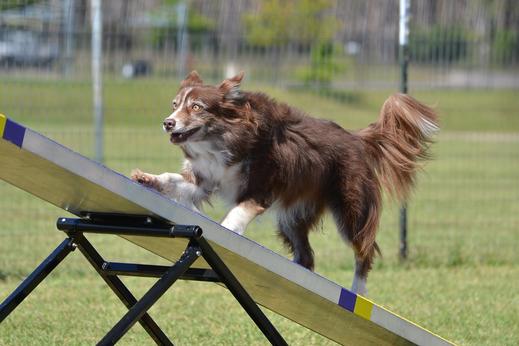6 Ways To Keep Your Big Dog Agile
If you’re the owner of a big dog, you may not think of agility as being something you would need to concern yourself with. “Agility” in this context is not about your dog running an obstacle course, it is about keeping him or her active and healthy.

Your big dog looks to you for his health and exercise and here are six ways to keep your big dog agile and his joints healthy:
Warm up exercises are as important for your pet as they are for you.
If you have a big dog that is capable of running long distances with you, great! We urge you to start out slowly, allow her to warm up her muscles and then begin your run. Dogs can get “sports” injuries and muscle pulls just as their humans can if they don’t warm up before a run.
Feed a healthy, balanced diet.
It’s as much about the brand of food you feed as it is the amount of food you feed your big dog. Ask your veterinarian for advice on the caloric intake your pet should have. This will likely depend on his age, activity level as well as the type of food you feed.
Keep your pet lean.
This goes along with feeding a healthy, balanced diet as well as making certain your big dog gets sufficient exercise. In a big dog, even an additional pound or two of body weight on her frame can lead to hip and joint issues. The more weight he has to carry, the more strain on his joints and greater chance he will suffer muscle aches.
Vary the exercise and activity your pet gets.
To keep your pet interested and to lessen the likelihood of an injury, go for a run with your big dog one day (if he is healthy enough to do so), take a long walk in hilly terrain the next, go swimming on another day, play fetch or other games in the backyard. Keep your dog mentally and physically stimulated.
Be vigilant in the care of your big dog.
If you notice he is limping after a long walk, check his paws to make certain there is nothing stuck between the pads or that he has cut himself. If the limp persists or if he cries out in pain if you touch it, call your veterinarian as he may have injured himself on the walk. If you notice she seems stiff when getting up or down, it could be a sign of an injury or arthritis. Does your dog do the “bunny hop” when she runs? This could be the sign of a leg or hip injury. Give your dog a comfortable place to lie when you’re done with your exercise and for all of the hours throughout the day when he is resting.
Build in recovery time.
Just as humans need time to rest and recover from a vigorous workout, so too does your big dog. If you run on one day, walk the next. Take a day off to simply lie around the house and relax together. This is especially true if you notice your dog developing any kind of a limp or if your veterinarian indicates he has canine arthritis. A dog with canine arthritis should still exercise, as moving will keep his joints limber and prevent them from seizing up; you might just need to slow down the level of activity or shorten your walks. Your veterinarian is your best source for advice on the level of activity that is safe for your big dog.
If you’ve ever wondered whether your dog is developing canine arthritis or what to do if he’s been diagnosed, grab a copy of our Canine Arthritis Guide.
You May Also Like: